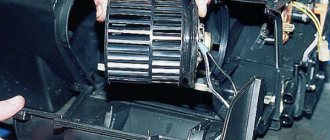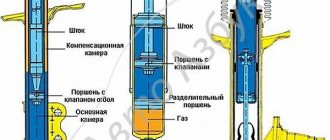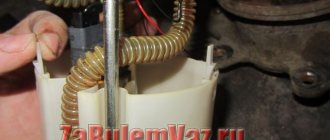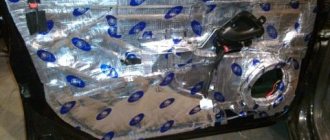Grant stove radiator
The location of the heater radiator on the Grant is not convenient for replacing it. To remove the radiator without damaging it, you will have to dismantle the dashboard, which can take a lot of time and labor due to a trivial problem that can be solved in an hour in other cars.
The radiator is located under the dashboard in its central part at the driver’s feet. Its pipes are hidden behind the decorative side panel trim. This location of the radiator makes it a little difficult to access it when replacing it, but if you use the correct replacement instructions, then removing and installing the radiator yourself will not be difficult.
Elements of the heating, air conditioning and ventilation system located in the interior of the LADA Granta
Rice. 1 (view with the instrument panel removed): 1 — left air duct: 2 — air supply duct to the central vents of the instrument panel; 3 — instrument panel frame; 4 — right air duct; 5 — recirculation block; b — air blower; 7 — fan electric motor; 8 — block of additional resistors; 9 - air duct (included with the air conditioner - installation location of the evaporator housing); 10 — heater block housing
The car is equipped with a liquid-type heater. Main heater components:
How to identify a clogged radiator
Checking the radiator is a fairly simple task that anyone can do. To do this, you need to check the circulation of fluid through the radiator. If the circulation is normal, then both radiator tubes will be hot, but if the inlet tube is hot and the outlet tube is cold, this indicates that the radiator is clogged from the inside.
A clogged radiator can be washed or, at best, replaced with a new one.
How does a stove fan work?
The main task of the fan is to take air flow from the outside and deliver it to the deflectors.
The fan is activated by a mechanical button, to which a 12 V power supply is supplied. In the Lada Granta version, the fan operates at one of three speeds. The driver selects the most optimal mode depending on the temperature inside the cabin.
Additional resistors Grants
Without resistors, the fan operates at one speed with a stable rpm. There are a total of 3 resistors installed on the board.
When the lever is moved to the first position (three resistors), the fan rotates at the first speed, the very minimum. Transfer to the second position - second speed (two resistors). Transfer to third - third speed (one resistor). The detailed diagram of the stove is shown in the photo.
Air distributor flap
Installed to regulate the air flow coming from the fan to the glass for blowing through air ducts.
Often, deformation and bending of the plastic body under the influence of temperature leads to flow leakage and depressurization.
Temperature control flap
Regulates the supply of warm air flow from the stove heater to the car interior. The wider the damper is open, the greater the throughput of the “channel”, and vice versa, the narrower it is, the less.
Heat exchanger Grants
Its main purpose is to heat the air flow entering the cabin. The heat exchanger is connected to the power unit through two rubber pipes: supply and return for fluid circulation.
The standard location is the central part of the dashboard of the car interior.
Types of Grant stove radiators
There are two types of radiators: with soldered pipes (factory radiator) and with removable ones.
Factory radiator with permanent pipes
The manufacturer produces radiators with non-removable pipes, that is, in order to dismantle it without removing the entire panel of the car, it is necessary to saw off the pipes coming from the radiator.
Radiator from Datsun with removable pipes
It is best to purchase a heater core from Datsun On-Do. The dimensions of the Datsun radiator are no different from the Grant one, with the exception of removable pipes, which will greatly reduce the pain during installation.
Block of additional resistors LADA Granta
The block of additional resistors 8 (see Fig. 1) consists of three resistors and a fuse. When current passes:
- through all three resistors, the 1st rotation speed of the heater fan is ensured,
- through two resistors - 2nd speed,
- after one -3rd speed.
- when the electric motor is turned on without an additional resistor, the armature of the fan motor rotates at the maximum 4th speed;
Step-by-step replacement process
It is necessary to remove the battery, the air filter box by pulling it out from the rubber dampers and remove the intake corrugation. You will need this to access the thermostat.
We drain the antifreeze from the cooling radiator by unscrewing the plug in the lower right part of the radiator. To drain, you will need a container of at least 10 liters.
Attention: It is necessary to drain the coolant when the engine is cold to avoid burns.
Remove the connector from the electronic accelerator pedal and unscrew the pedal from the car body using a 10mm socket wrench. Then remove the pedal from the studs.
Unscrew the screws securing the radiator cap with a 6 mm wrench and remove it.
We remove the radiator pipes and lower them down so that the remaining antifreeze drains.
Now you need to press down the brake pedal; to do this, remove the cotter pin that secures the pedal and press on it when we remove the radiator.
If the radiator is not dismountable, that is, the pipes are not removable, they must be sawed off with a hacksaw. If the pipes are removed, they must be removed and pulled out of the holes in the engine shield.
After removing the pipes, you can pull out the radiator by pressing the brake pedal down.
We install the new radiator in the same way, pressing down the brake pedal, first removing the pipes from the radiator and installing them after the radiator is placed in its seat.
If the radiator is not prefabricated, then the pipes can be sawed off and the connection can be made on the hoses.
Reviews
| № | Positive |
| 1. | Vasily: for two years of operation there were no breakdowns of the heating system. Several times I noticed an antifreeze leak at the joints of the pipes. After replacing the clamp with a new one, there were no cases of depressurization. |
| 2. | Vladlen: Granta is assembled with high quality, the fit of parts is good, there are no comments. Provided regular maintenance, it will last a long time. |
| 3. | Gennady: for a year and a half of active use of the machine, I did not make any capital investments, with the exception of the purchase of consumables. I treat equipment with care, I buy only original parts. |
| 4. | Ivan: I recently underwent the fifth maintenance, the master assured me that the equipment was in good working order, there were no comments. |
| 5. | Dmitry: at 50,000 km, I replaced the return pipe once due to the formation of a crack. The system is operating normally, there are no complaints. |
| 6. | Ignat: my machine works like a watch, no complaints. I carry out technical inspections in a timely manner, fill with high-quality oils and high-octane fuel, and strictly follow the manufacturer’s recommendations. |
| 7. | Victor: It will soon be two years since I bought a Lada, I’m happy with the choice. My friends advised me to buy a Renault Logan, but I chose a domestic one. |
| Negative | |
| 1. | Ivan: I’m dissatisfied with the purchase of the Lada Grant; in the first winter, the antifreeze supply pipe to the radiator cracked. Fortunately, I noticed it in time and replaced it with a new one, otherwise the consequences could have been different. |
| 2. | Sergey: during the year and a half of operation of the car, the car underwent unscheduled repairs twice. I think this is too much for domestic transport. |
| 3. | Gennady: Now I regret buying Granta; Renault Logan is better. The car is falling apart every day. |
Conclusion There are difficulties when dismantling the stove heater. Many owners are familiar with this. At the same time, the “craftsmen” came up with a way to replace the heat exchanger without actually removing the dashboard, which significantly reduces time, money, and effort.
The final choice is up to the owner of the technical equipment. You should still listen to the recommendations of experts.
Lada Granta has become a really popular car. And, in many ways, this happened thanks to the affordable price and good components. For example, the stove installed on the Lada Granta is quite good, as it warms up the interior to the required level very quickly. AvtoVAZ engineers did a very good job on this issue, since for our harsh winters the issue of high-quality heating of the interior is very relevant.
Heating system control
To adjust the fan speed mode, the regulator has a gradation scale. The car owner independently selects the optimal fan rotation mode.
Heating system regulator in the cabin
Failure of the regulator blocks the operation of the entire vehicle interior heating system.
Interior ventilation and heating system of Lada Granta: checking, adjustment
The type of interior ventilation and heating system is supply and exhaust. The operating temperature of the interior heating fluid is in the range from 90 to 94°.
Warm (hot) air is supplied to the cabin by an electric fan. The feed speed is adjusted by a special regulator, which accelerates (reduces) the rotation speed of the impeller.
The electric motor has four positions:
- first;
- second;
- third speed;
- position: off
Stove motor
Air intake follows from the outside through air intakes under the frill in the engine compartment. A filter is pre-installed to clean the flow. Filling: synthetic material.
Air is exhausted through a ventilation window in the rear of the car, behind the bumper.
The heater module is installed in the central part of the dashboard, under the panel. During engine operation, the liquid heats up and circulates along the circuit (water jacket).
The amount of air that comes from outside is regulated by the driver. The flow distribution is also controlled by a damper using a cable drive.
Diagnostics of the stove heating system
- We place the car within the perimeter of the repair area and open the hood.
- Let's start the engine.
- Turn the regulator counterclockwise to the blue sector.
- Using the lever, we alternately activate the first, second, third fan speeds.
If the fan does not change speed, then the cause of the malfunction is in the resistors.
If the fan does not activate, then there is a fault in the power circuit.
We carry out diagnostics using a multimeter.
- We activate the stove heater damper; if no changes occur, then the damper drive is faulty.
- After the engine has warmed up to a temperature of 60 - 70°, turn the regulator lever to the red sector position.
- We check the air temperature, it should correspond to degrees. Otherwise, the damper drive is faulty.
- If necessary, repeat the procedure by moving the regulator to the blue sector position.










